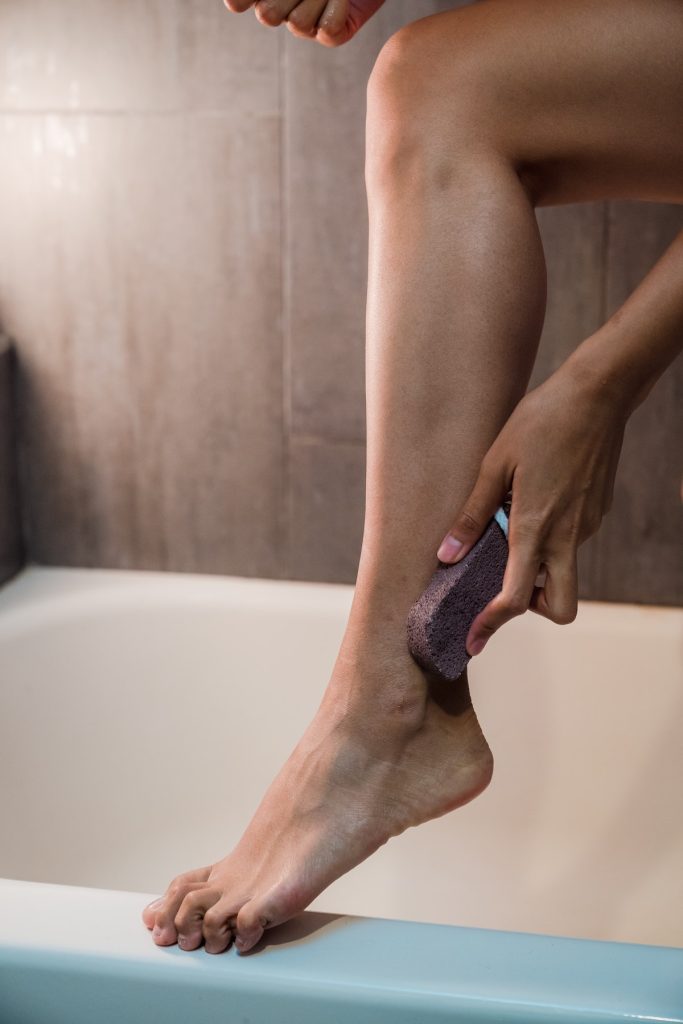Who doesn’t want better skin? You’ve likely tried many approaches to achieving it, from fitness routines to balanced diets. But if you’re looking to improve a certain part of your body, like the feet, some exfoliation may be in order.
It’s time to get acquainted with the pumice stone.
It may be called a “stone,” but this lightweight and rough tool is no ordinary rock. It has been used for centuries by people all over the world as an effective means of removing dead skin cells, from callouses to corns.
But what is a pumice stone really? How does one use it properly to achieve the desired results?
What’s a Pumice Stone?

A pumice stone is formed from volcanic eruptions. The same sort of magma that creates granite produces pumice: that light yet rough stone used generally for exfoliation. Its fine grains and sponge-like appearance make it ideal for filing away dead skin cells, which is usually done in two ways. And each comes with pros and cons.
Wet: Soaking your feet in warm water before using the pumice stone will help to soften the skin and make it easier to remove dead cells. This method is recommended for people with sensitive skin, as it can be less abrasive than using the stone dry.
Dry: For those who don’t mind a little bit of pain, using a pumice stone dry is more effective for removing callouses and other tough skin buildup. It can be a bit more abrasive than using it wet, so be careful not to overdo it.
Which method is right for you?
The best way to use a pumice stone is the method that works for you. Consider your skin type, the amount of time available to use it and how many callouses need to be removed.
How to Use a Pumice Stone for Feet: Wet Method
- Soak your feet in warm water for about five minutes before using the pumice stone. This will help to soften the skin and make it easier to remove dead cells.
- Gently rub the wet pumice stone over all of the calloused areas on your feet
- Continue doing this until all of the dead skin is gone
- Rinse your feet off with cool water and pat them dry
- Apply a moisturizer to keep your feet feeling soft and smooth
How to Use a Pumice Stone for Feet: Dry Method
- Rub the pumice stone over all of the calloused areas on your feet, being careful not to apply too much pressure
- Do this for two or three minutes, until your feet feel smooth
- Rinse off and pat dry
That’s it. However, if you do not like the results after trying out a pumice stone for yourself, there are other options to try as well.
Alternatives to Using a Pumice Stone on Feet

Although using a pumice stone is always an option, some people prefer alternatives that can be just as effective at exfoliating dead skin cells without the rough texture of the rock itself. These include:
- sandals or socks with foot scrubs embedded in them;
- pedicures performed by professionals;
- salt rubs, and
- even body wash formulated especially for use on feet.
Wetting your calloused areas before applying any product makes it easier to work with, but it is not required.
How to Clean a Pumice Stone
To clean your pumice stone, simply soak it in warm water for five minutes. After, scrub away any remaining dead skin cells with a nail brush or sponge and rinse off before patting dry.
Store the stone somewhere cool and dry until its next use.
Why is pumice stone aftercare necessary?
Just like any other exfoliating treatment, using a pumice stone can leave your feet feeling a little bit dry. This is why it’s important to follow up with some good quality foot cream or lotion after using the stone. Doing so will help to keep your feet from becoming too irritated or inflamed and will maintain the results you achieved while using the pumice stone.
Do Pumice Stones Go Bad?
No, pumice stones do not go bad. However, if they are not cleaned properly after each use, bacteria can build up and cause skin irritation.
It’s also a good idea to replace your pumice stone every few months or so, as the rough surface can start to wear down over time.
But is this known callus remover for feet only used for skin treatment? Does a pumice stone serve other purposes?
What’s Special About a Pumice Stone?

A pumice stone is a lightweight and rough tool that has been used for centuries by people all over the world to remove dead skin cells from callouses, corns or any other hard-to-reach places on their feet. But does this known foot care item serve more than one purpose?
The answer would seem affirmative when considering how it can be:
- Employed as an efficient way of removing make up in around your eyes without irritating them; Effectively exfoliating dry elbows after sitting too long at t heir computer desk;
- Improving blood circulation, hence better muscle recovery time following strenuous exercise routines, and
- Getting rid those pesky blackheads you may have found between nose hair follicles.
Pumice stones are one of the most popular beauty products on the market. Originally used as a tool for removing dead skin, pumice stone has since become common in cosmetics and homecare products.
But did you know that this wonderful stone also has other uses?
Remove rust
If you have any rusty tools or hardware, pumice stone can be a great way to remove that rust.
Remove stains
Pumice stone is perfect for removing any stubborn food or drink stains from countertops, appliances, tiled walls.
Groom pets
If you have long haired pet like a cat or dog, pumice stone can be a great way to help groom them. The rough surface of the stone will help remove any excess hair and dirt. Just use it lightly to keep your pet’s skin safe.
Remove paint
If you’re painting your home or just doing some touch-ups, pumice stone can be a great way to remove the old paint. Just make sure you use it sparingly – you don’t want to damage the surface underneath
Remove adhesive
If you need to remove any old adhesive or labels, pumice stone can do the trick. Just make sure you soak the area in warm water first so the adhesive will be easier to remove.
Polish jewelry
Pumice stone is the perfect solution for polishing your jewelry.
Polish shoes
Pumice stones can do more than just remove calluses – they are also great at getting rid of scuff marks on leather. Just rub it across the shoe in a circular motion to get that shine back.
Clean dishes
The rough surface helps scrub away any food particles or grease, making your dishes sparkle. You can also use pumice stone to scrub the inside of dirty pots and pans.
Scrub floors
Pumice stones are great for cleaning up tile flooring since they help remove dirt and grime without damaging the surface. Just add a little bit of water for a deep clean.
Scour pots and pans
If you have some dirty pots or pans, pumice stone can be the perfect solution for getting rid of any caked-on food particles.
Scrub toilets
Pumice stones are the perfect tool for cleaning up your toilet. The rough surface helps remove any stains or baked-on dirt that other tools can’t get rid of.
Get rid of hair dye stains
Another great way to use pumice stones is to remove hair dye stains from your scalp.
Sharpen blades
Pumice stone is also perfect for sharpening any dull knives or tools. Just make sure not to use it on anything too delicate, as the blade could get scratched.
Key Takeaways
- A pumice stone is a lightweight and rough tool that has been used for centuries by people all over the world to remove dead skin cells from callouses to corns.
- Soaking your feet in warm water before using the pumice stone will help to soften the skin and make it easier to remove dead cells.
- For those who don’t mind a little bit of pain, using a pumice stone dry is more effective for removing callouses and other tough skin build-up.
- The best way to use a pumice stone is the method that works for you. Consider your skin type, the amount of time available to use it and how many callouses need to be removed.
- While using a pumice stone is always an option, some people prefer alternatives that can be just as effective at exfoliating dead skin cells without the rough texture of the rock itself. These include sandals or socks with foot scrubs embedded in them; pedicures performed by professionals; salt rubs; and even body wash formulated especially for use on feet.
Although it’s known the world over as the callus remover for feet, a pumice stone does more than exfoliate. From scrubbing toilets and grooming pets, now you know that this stone is something special.


